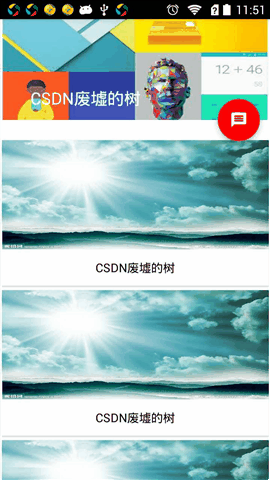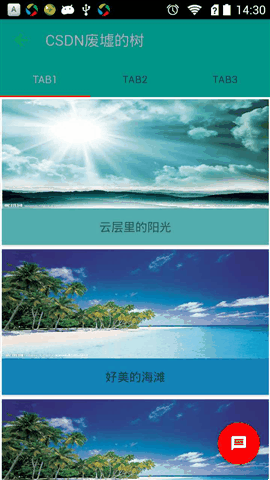Android M新控件之AppBarLayout,NavigationView,CoordinatorLayout,CollapsingToolbarLayout的使用
【转载请注明出处:http://blog.csdn.net/feiduclear_up/article/details/46514791 CSDN 废墟的树】
上一篇博客我们学习了Android Design Support Library库中的 是个简单的组件,不了解的童鞋可以参考之前的博客
Android M新控件之FloatingActionButton,TextInputLayout,Snackbar,TabLayout的使用。
这篇博客我们继续学习Design库中的其他四个组件,分别是AppBarLayout,NavigationView,CoordinatorLayout,CollapsingToolbarLayout。
同样,你需要在你的工程中引入
compile 'com.android.support:design:22.2.0'AppBarLayout
效果图是这样的
AppBarLayout 是继承LinerLayout实现的一个ViewGroup容器组件,它是为了Material Design设计的App Bar,支持手势滑动操作。
默认的AppBarLayout是垂直方向的,它的作用是把AppBarLayout包裹的内容都作为AppBar。类似上面图片贴出来的效果,代码布局如下:
<android.support.design.widget.AppBarLayout
android:id="@+id/appbar"
android:layout_width="match_parent"
android:layout_height="wrap_content">
<android.support.v7.widget.Toolbar
android:id="@+id/toolbar"
android:layout_width="match_parent"
android:layout_height="?attr/actionBarSize"
android:background="?attr/colorPrimary"
android:minHeight="?attr/actionBarSize"></android.support.v7.widget.Toolbar>
<android.support.design.widget.TabLayout
android:id="@+id/tabs"
android:layout_width="match_parent"
android:layout_height="wrap_content"
app:layout_scrollFlags="scroll"
app:tabIndicatorColor="@android:color/holo_red_dark"
app:tabSelectedTextColor="@android:color/holo_red_dark"
app:tabTextColor="@android:color/black" />
</android.support.design.widget.AppBarLayout>此处将Toolbar 和Tablayout的组合部分共同构成 AppBar的效果。
注意: AppBarLayout必须作为Toolbar的父布局容器
AppBarLayout是支持手势滑动效果的,不过的跟CoordinatorLayout配合使用,接下来学习一下CoordinatorLayout组件怎么使用?
CoordinatorLayout
从开发文档中可以了解到,CoordinatorLayout是一个增强型的FrameLayout。它的作用有两个
- 作为一个布局的根布局
- 最为一个为子视图之间相互协调手势效果的一个协调布局
例如一下布局代码:
<?xml version="1.0" encoding="utf-8"?>
<android.support.design.widget.CoordinatorLayout xmlns:android="http://schemas.android.com/apk/res/android"
xmlns:app="http://schemas.android.com/apk/res-auto"
android:id="@+id/main_content"
android:layout_width="match_parent"
android:layout_height="match_parent">
<android.support.design.widget.AppBarLayout
android:id="@+id/appbar"
android:layout_width="match_parent"
android:layout_height="wrap_content">
<android.support.v7.widget.Toolbar
android:id="@+id/toolbar"
android:layout_width="match_parent"
android:layout_height="?attr/actionBarSize"
android:background="?attr/colorPrimary"
app:layout_scrollFlags="scroll|enterAlways" />
<android.support.design.widget.TabLayout
android:id="@+id/tabs"
android:layout_width="match_parent"
android:layout_height="wrap_content"
app:tabGravity="fill" />
</android.support.design.widget.AppBarLayout>
<!--可滑动的布局内容-->
<android.support.v7.widget.RecyclerView
android:id="@+id/recyclerView"
android:layout_width="match_parent"
android:layout_height="wrap_content"
app:layout_behavior="@string/appbar_scrolling_view_behavior" />
<android.support.design.widget.FloatingActionButton
android:layout_width="wrap_content"
android:layout_height="wrap_content"
android:src="@drawable/ic_discuss"
android:layout_gravity="bottom|end"/>
</android.support.design.widget.CoordinatorLayout>从上面布局看到,CoordinatorLayout协调布局中包裹了两个布局,一个是NestedScrollView,一个是AppBarLayout,以及FAB按钮。
我们来看看CoordinatorLayout是怎么来协调这两个子视图手势操作的。
1.由于CoordinatorLayout是FrameLayout布局,我们可以通过
android:layout_gravity="bottom|end"属性来控制组件在整个布局中的位置,比如上面效果中的FAB就是通过android:layout_gravity=”bottom|end”来确定 FAB的位置在底端的最右边的位置。
2.为了达到上面效果图的手势动画效果,我们必须做如下设置,通过app:layout_scrollFlags=”scroll|enterAlways” 属性来确定哪个组件是可滑动的
设置的layout_scrollFlags有如下几种选项:
- scroll: 所有想滚动出屏幕的view都需要设置这个flag- 没有设置这个flag的view将被固定在屏幕顶部。
- enterAlways: 这个flag让任意向下的滚动都会导致该view变为可见,启用快速“返回模式”。
- enterAlwaysCollapsed: 当你的视图已经设置minHeight属性又使用此标志时,你的视图只能已最小高度进入,只有当滚动视图到达顶部时才扩大到完整高度。
- exitUntilCollapsed: 滚动退出屏幕,最后折叠在顶端。
我们上面的布局中 给Toolbar设置了app:layout_scrollFlags属性,因此,Toolbar是可以滚动出屏幕,且向下滚动有可以出现。
3.为了使得Toolbar可以滑动,我们必须还得有个条件,就是CoordinatorLayout布局下包裹一个可以滑动的布局,比如 RecyclerView,NestedScrollView(经过测试,ListView,ScrollView不支持)具有滑动效果的组件。并且给这些组件设置如下属性来告诉CoordinatorLayout,该组件是带有滑动行为的组件,然后CoordinatorLayout在接受到滑动时会通知AppBarLayout 中可滑动的Toolbar可以滑出屏幕了。
app:layout_behavior="@string/appbar_scrolling_view_behavior"总结: 为了使得Toolbar有滑动效果,必须做到如下三点:
- CoordinatorLayout必须作为整个布局的父布局容器。
- 给需要滑动的组件设置 app:layout_scrollFlags=”scroll|enterAlways” 属性。
- 给你的可滑动的组件,也就是RecyclerView 或者 NestedScrollView 设置如下属性:
app:layout_behavior="@string/appbar_scrolling_view_behavior"CollapsingToolbarLayout
CollapsingToolbarLayout包裹 Toolbar 的时候提供一个可折叠的 Toolbar,一般作为AppbarLayout的子视图使用。
CollapsingToolbarLayout 提供以下属性和方法是用:
- Collapsing title:ToolBar的标题,当CollapsingToolbarLayout全屏没有折叠时,title显示的是大字体,在折叠的过程中,title不断变小到一定大小的效果。你可以调用setTitle(CharSequence)方法设置title。
- Content scrim:ToolBar被折叠到顶部固定时候的背景,你可以调用setContentScrim(Drawable)方法改变背景或者 在属性中使用 app:contentScrim=”?attr/colorPrimary”来改变背景。
- Status bar scrim:状态栏的背景,调用方法setStatusBarScrim(Drawable)。还没研究明白,不过这个只能在Android5.0以上系统有效果。
- Parallax scrolling children:CollapsingToolbarLayout滑动时,子视图的视觉差,可以通过属性app:layout_collapseParallaxMultiplier=”0.6”改变。
- CollapseMode :子视图的折叠模式,有两种“pin”:固定模式,在折叠的时候最后固定在顶端;“parallax”:视差模式,在折叠的时候会有个视差折叠的效果。我们可以在布局中使用属性app:layout_collapseMode=”parallax”来改变。
布局代码如下:
<?xml version="1.0" encoding="utf-8"?>
<android.support.design.widget.CoordinatorLayout xmlns:android="http://schemas.android.com/apk/res/android"
xmlns:app="http://schemas.android.com/apk/res-auto"
android:layout_width="match_parent"
android:layout_height="match_parent">
<android.support.design.widget.AppBarLayout
android:id="@+id/appbar"
android:layout_width="match_parent"
android:layout_height="160dp">
<android.support.design.widget.CollapsingToolbarLayout
android:id="@+id/collapsing_toolbar"
android:layout_width="match_parent"
android:layout_height="match_parent"
app:expandedTitleMarginEnd="64dp"
app:contentScrim="?attr/colorPrimary"
app:expandedTitleMarginStart="48dp"
app:statusBarScrim="?attr/colorPrimary"
app:layout_scrollFlags="scroll|exitUntilCollapsed"
>
<ImageView
android:id="@+id/image"
app:layout_collapseParallaxMultiplier="0.6"
android:layout_width="match_parent"
android:layout_height="match_parent"
android:scaleType="fitXY"
android:src="@drawable/image"
app:layout_collapseMode="parallax" />
<android.support.v7.widget.Toolbar
android:id="@+id/toolbar"
android:layout_width="match_parent"
android:layout_height="?attr/actionBarSize"
app:layout_collapseMode="pin"
app:popupTheme="@style/ThemeOverlay.AppCompat.Light"></android.support.v7.widget.Toolbar>
</android.support.design.widget.CollapsingToolbarLayout>
</android.support.design.widget.AppBarLayout>
<--your scroll content-->可滑动的内容
<android.support.v4.widget.NestedScrollView
android:layout_width="match_parent"
android:layout_height="wrap_content"
app:layout_behavior="@string/appbar_scrolling_view_behavior">
</android.support.v4.widget.NestedScrollView>
<android.support.design.widget.FloatingActionButton
android:layout_width="wrap_content"
android:layout_height="wrap_content"
android:src="@drawable/ic_discuss"
app:backgroundTintMode="multiply"
app:layout_anchor="@id/appbar"
app:layout_anchorGravity="bottom|end|right"></android.support.design.widget.FloatingActionButton>
</android.support.design.widget.CoordinatorLayout>总结: CollapsingToolbarLayout主要是提供一个可折叠的Toolbar容器,对容器中的不同视图设置layout_collapseMode折叠模式,来达到不同的折叠效果。
1.Toolbar 的高度layout_height必须固定,不能 “wrap_content”,否则Toolbar不会滑动,也没有折叠效果。
2.为了能让FloatingActionButton也能折叠且消失出现,我们必须给FAB设置锚点属性
app:layout_anchor="@id/appbar"意思是FAB浮动按钮显示在哪个布局区域。
且设置当前锚点的位置
app:layout_anchorGravity=”bottom|end|right”
意思FAB浮动按钮在这个布局区域的具体位置。
两个属性共同作用才是的FAB 浮动按钮也能折叠消失,出现。
3.给需要有折叠效果的组件设置 layout_collapseMode属性。
【转载请注明出处:http://blog.csdn.net/feiduclear_up/article/details/46514791 CSDN 废墟的树】
NavigationView
用于侧滑菜单中的menu布局。之前Google在V4包中推出自己的 DrawerLayout作为抽屉侧滑菜单,标准使用方法可以参考 google 原生态 抽屉式侧滑菜单 Android DrawerLayout 布局的使用介绍。
当时的官方布局是这样的:
<android.support.v4.widget.DrawerLayout xmlns:android="http://schemas.android.com/apk/res/android" android:id="@+id/drawer_layout" android:layout_width="match_parent" android:layout_height="match_parent" >
<!-- the main content view -->
<FrameLayout android:id="@+id/frame_content" android:layout_width="match_parent" android:layout_height="match_parent" >
</FrameLayout>
<!-- the navigetion view -->
<ListView android:id="@+id/drawer_list" android:layout_width="240dp" android:layout_height="match_parent" android:layout_gravity="start" android:background="#9999cc" android:choiceMode="singleChoice" android:divider="@android:color/transparent" android:dividerHeight="0dp" >
</ListView>
</android.support.v4.widget.DrawerLayout> 其实这次谷歌只是将上面的ListView布局替换成NavigationView了。简化了之前ListView写适配器的繁琐。
先如今布局改成如下:
<android.support.v4.widget.DrawerLayout xmlns:android="http://schemas.android.com/apk/res/android" xmlns:app="http://schemas.android.com/apk/res-auto" android:id="@+id/drawer_layout" android:layout_width="match_parent" android:layout_height="match_parent">
<!-- the main content view -->
<include layout="@layout/layout_content" />
<!-- the navigetion view -->
<android.support.design.widget.NavigationView android:id="@+id/navigationView" android:layout_width="wrap_content" android:layout_height="match_parent" android:layout_gravity="left" android:fitsSystemWindows="true" app:headerLayout="@layout/layout_header" app:menu="@layout/layout_menu">
</android.support.design.widget.NavigationView>
</android.support.v4.widget.DrawerLayout> 其中NavigationView 中的 android:layout_gravity=”start” 属性来控制抽屉菜单从哪边滑出,一般“start ”从左边滑出,“end”从右边滑出。
这里最主要的两个属性分别是:
1.app:headerLayout: 给NavigationView添加头部布局
2.app:menu:给NavigationView添加menu菜单布局
app:headerLayout布局如下:
<?xml version="1.0" encoding="utf-8"?>
<LinearLayout xmlns:android="http://schemas.android.com/apk/res/android" android:layout_width="match_parent" android:layout_height="200dp" android:background="@drawable/img1" android:gravity="center" android:orientation="vertical">
<ImageView android:layout_width="125dp" android:layout_height="125dp" android:scaleType="centerCrop" android:src="@drawable/image" />
<TextView android:layout_marginTop="15dp" android:layout_width="wrap_content" android:layout_height="wrap_content" android:text="CSDN废墟的树博客" android:textColor="@android:color/white" />
</LinearLayout>app:menu 布局如下:
<?xml version="1.0" encoding="utf-8"?>
<menu xmlns:android="http://schemas.android.com/apk/res/android" android:layout_width="match_parent" android:layout_height="match_parent">
<group android:checkableBehavior="single" android:title="Home items">
<item android:id="@+id/nav_blog" android:icon="@drawable/ic_account_balance_black_24dp" android:title="博客地址" />
<item android:id="@+id/nav_ver" android:icon="@drawable/ic_error_outline_black_36dp" android:title="版本信息" />
<item android:id="@+id/nav_about" android:icon="@drawable/ic_error_outline_black_36dp" android:title="关于我" />
</group>
<item android:title="Sub items">
<menu>
<item android:id="@+id/sub_exit" android:icon="@drawable/ic_power_settings_new_black_36dp" android:title="退出应用" />
<item android:id="@+id/sub_switch" android:icon="@drawable/ic_settings_applications_black_36dp" android:title="切换主题" />
</menu>
</item>
</menu>代码中控制NavigationView
private void initNavigationView(){
navigationView = (NavigationView) findViewById(R.id.navigationView);
drawerLayout = (DrawerLayout) findViewById(R.id.drawer_layout);
//设置侧滑菜单选择监听事件
navigationView.setNavigationItemSelectedListener(new NavigationView.OnNavigationItemSelectedListener() {
@Override
public boolean onNavigationItemSelected(MenuItem menuItem) {
menuItem.setChecked(true);
//关闭抽屉侧滑菜单
drawerLayout.closeDrawers();
return true;
}
});
}
@Override
public boolean onOptionsItemSelected(MenuItem item) {
if (item.getItemId() == android.R.id.home){
//打开抽屉侧滑菜单
drawerLayout.openDrawer(GravityCompat.START);
}
return super.onOptionsItemSelected(item);
}关于NavigationView中item的字体颜色和icon选中状态颜色是去当前主题theme中的
<--正常状态下字体颜色和icon颜色-->
<item name="android:textColorPrimary">@android:color/darker_gray</item>
<--选中状态icon的颜色和字体颜色-->
<item name="colorPrimary">@color/accent_material_light</item>当然你可以通过如下方法或者属性来改变这一状态:
- setItemBackgroundResource(int):给menu设置背景资源,对应的属性app:itemBackground
- setItemIconTintList(ColorStateList):给menu的icon设置颜色,对应的属性app:itemIconTint
- setItemTextColor(ColorStateList):给menu的item设置字体颜色,对应的属性app:itemTextColor
至此,Android Support Design Library库的使用基本学习完。
源码地址 https://github.com/xujinping/AndroidDesignLibrary/tree/master



